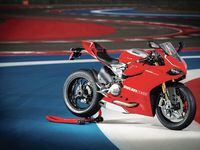By any standards you care to name, sportbike performance is pretty phenomenal. Power, torque, weight, acceleration, braking, and handling have been developed to a strikingly high level. But this development has been focused on a technical package that is almost cookie-cutter uniform (with an exception that I’ll get to).
Intense competition among the manufacturers means that attractive features added by one are quickly incorporated into the machines of the others. The net effect is to make it seem that these machines are being developed in a kind of overall industry effort to produce great products that are at the same time one product: the (almost) perfect high-performance motorcycle.
So, you have a high level of development effort focused on a relatively narrow slice of technology. A predictable result of such a situation is that it becomes ever more difficult and expensive for manufacturers to incrementally improve the performance of their product and to maintain their competitive position in the market. Where several years ago it may have taken an investment of $X million to improve a performance category by 5 percent, it may now take that much money to gain, say, 2 percent. That previous 5 percent “return” on the money that’s now a 2 percent return is the problem under discussion: diminishing returns.
Diminishing returns are typical in a “mature” technology that has been intensely developed, and especially one in which the development has been pursued so competitively. Are there options to change or alleviate this situation, to keep returns coming at the previous pace?
One solution is to basically “lower the bar” by reducing development goals and expectations. The MotoGP and Superbike racing series both understand the threat of diminishing returns. In MotoGP, both Kawasaki and Suzuki saw that their competitive positions and the benefits from racing (returns) no longer justified the costs, and they left the series. To keep the other manufacturers involved, MotoGP has instituted many rules that lower performance expectations. Minimum weight limits mean that development programs for weight reduction can be cut back, and the bikes themselves can be less expensive. Rev limits to be imposed next year will similarly mean less expense both in hardware and development.
In Superbike, the rule strategies are a bit different but the intent is the same. The general trend is to move the bikes closer to stock configuration by limiting modifications. One example, new this year, is using stock-size 17-inch aluminum wheels rather than the previous 16.5-in. magnesium rims. Minimum weights apply here as well, with the organizer able to change weights to adjust competitiveness between brands.
The racing rules don’t necessarily help the manufacturers out of the bind of diminishing returns, but since racing to a great extent sets and defines goals in the sportbike market, they may lower expectations a bit. In any case, rules certainly lower the cost of competing and serve to blunt an all-out race for dominance in various performance categories.
Another option to avoid diminishing returns is for manufacturers to pursue new technologies. The most original high-performance machine available now is the Ducati 1199 Panigale, definitely not a cookie-cutter sportbike. The Panigale’s “frameless” chassis is its innovative heart. A cast-aluminum structure bolts to the cylinder heads to carry the steering head and also serve as the airbox. The rear suspension, including the linkage and shock, bolts to the back of the engine. Combined, the engine and frameless chassis save 22 pounds over the previous superbike—the kind of weight savings that you don’t see when diminishing returns govern development.
Diminishing returns don’t mean technology stands still. It only means that progress becomes more difficult to achieve. Sportbikes will still offer spectacular performance, even if the exciting updates come more and more infrequently, and in smaller doses.











/cloudfront-us-east-1.images.arcpublishing.com/octane/VZZXJQ6U3FESFPZCBVXKFSUG4A.jpg)
/cloudfront-us-east-1.images.arcpublishing.com/octane/QCZEPHQAMRHZPLHTDJBIJVWL3M.jpg)
/cloudfront-us-east-1.images.arcpublishing.com/octane/HXOUJXQWA5HBHGRO3EMJIGFMVI.jpg)

/cloudfront-us-east-1.images.arcpublishing.com/octane/3TIWWRV4JBBOLDVGRYECVVTA7Y.jpg)
/cloudfront-us-east-1.images.arcpublishing.com/octane/KIX5O23D5NAIBGFXBN3327DKZU.jpg)
/cloudfront-us-east-1.images.arcpublishing.com/octane/7GJYDUIPXRGMTMQKN6ONYOLBOU.jpg)
/cloudfront-us-east-1.images.arcpublishing.com/octane/MUQLOVLL2ZDGFH25ILABNBXKTI.jpg)
/cloudfront-us-east-1.images.arcpublishing.com/octane/TNOU5DNE2BC57MFPMGN2EIDXAM.jpg)
/cloudfront-us-east-1.images.arcpublishing.com/octane/GTCXACQGJ5HAPDTGWUQKDEH44E.jpg)
/cloudfront-us-east-1.images.arcpublishing.com/octane/S35YGSEMEZB4BLTDJTSZPF4GLA.jpg)
/cloudfront-us-east-1.images.arcpublishing.com/octane/5UOT6HPX2JFMRJAX6EH45AR4MQ.jpg)
/cloudfront-us-east-1.images.arcpublishing.com/octane/OKWOJWAKP5EP3OACCRRWPCIX2Q.jpg)
/cloudfront-us-east-1.images.arcpublishing.com/octane/2WF3SCE3NFBQXLDNJM7KMXA45E.jpg)
/cloudfront-us-east-1.images.arcpublishing.com/octane/G4MG6OUCJNBSHIS2MVVOTPX65E.jpg)
/cloudfront-us-east-1.images.arcpublishing.com/octane/IIGGWFOTOJGB7DB6DGBXCCMTDY.jpg)
/cloudfront-us-east-1.images.arcpublishing.com/octane/QSTCM6AVEZA5JJBUXNIQ3DSOF4.jpg)
/cloudfront-us-east-1.images.arcpublishing.com/octane/U4I7G625B5DMLF2DVIJDFZVV6M.jpg)
/cloudfront-us-east-1.images.arcpublishing.com/octane/B6XD6LS6IVCQPIU6HXDJSM3FHY.jpg)
/cloudfront-us-east-1.images.arcpublishing.com/octane/ICL63FEDDRDTTMINYICCEYGMDA.jpg)
/cloudfront-us-east-1.images.arcpublishing.com/octane/FCGZHQXRBZFLBAPC5SDIQLVF4I.jpg)
/cloudfront-us-east-1.images.arcpublishing.com/octane/WNOB6LDOIFFHJKPSVIWDYUGOPM.jpg)

/cloudfront-us-east-1.images.arcpublishing.com/octane/X33NU3E525ECRHXLNUJN2FTRKI.jpg)